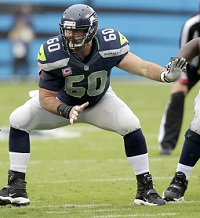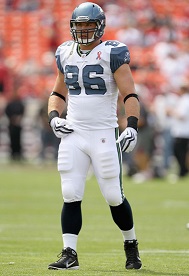[adsenseyu1]
A few weeks ago Jason LaCanfora published a list of best and worst contracts in the NFL so I thought it might make a good idea for us to do the same here at OTC, with a team by team approach. I’ll try to be a bit more analytical in terms of why money was paid and how it fits in the market, but the general premise is the same. The one key difference is outside of restructured rookie contracts under the old CBA we will only use veteran contracts as there is a big difference between best draft picks and best contracts. Please note that there is a difference between a bad player and a bad contract when discussing some of the selections. Clicking on a players name will take you to his salary cap page.
 Best Contract: Max Unger
Best Contract: Max Unger
I guess it is worth pointing out again that I’m not considering rookie deals for best value unless the rookie contract had something out of the ordinary in it. So that is why Russell Wilson isn’t here. Sure he is the best bargain on the team, but there is almost no thought process to the rookie contract. His value is due to the draft selection not due to any negotiation or value pricing of the player.
Finding the best contract on the Seahawks is not the easiest task. They have run a contractual system that is very close to that of the New York Jets in terms of conditional guarantees and modest signing bonuses that tend to drive prices of players a little higher and can be damaging to the cap when such a player fails to work out. The two contracts that stand out as better than others on the team are those given to C Max Unger and S Kam Chancellor.
To be honest I could see naming either player as the best contract. Both provide escape dates and those escape dates are not met with excessive cap charges or other payouts. Both are well priced deals but I chose Unger for two reasons. One is that you can make an argument that he is the best Center in the NFL but the Seahawks didn’t have to go into the crazy Center money territory that the Jets and Panthers went to with Nick Mangold and Ryan Kalil. The other is that there were no vesting dates for his guarantees. Only his 2013 salary was fully guaranteed and after that the Seahawks, if needed, could easily use the June 1 designations on him. Chancellor has two sets of vesting guarantees that occur in February.
Unger’s contract, which was worth just under $25 million for 4 seasons, represented a 24% savings in annual value over Ryan Kalil’s contract with the Panthers. His $11.5 million in guarantees is less than Chris Myers of the Texans and Scott Wells of the Rams. The contract itself is also a well structured deal with no real peaks or valleys making the cap management job of such a player relatively worry free. His cap charges fluctuate from $5.6 to $6 million, though there is some room for small escalators to advance those numbers.
The contract figures are very manageable and with no spikes there is never a point where the Seahawks will be forced to renegotiate the terms of the contract for cap relief as will likely happen with Mangold in 2014 and has already happened with (and will likely happen again with) Kalil. This is the kind of deal that both sides should be happy with over the term of the contract especially if Unger continues to prove himself to be one of the best in the game.
 Worst Contract: Zach Miller
Worst Contract: Zach Miller
Because of the rivalry between the two teams in 2012, the Seahawks are often compared to the 49’ers from the top all the way down. From a player valuation and contractual design standpoint that should not be the case, There were a number of players to look at here at bloated salaries and relatively damaging contract structures. Both the Percy Harvin and Sidney Rice contracts were way out in left field type deals. Rice has never lived up to the salary and Harvin is going to have to develop into a different level of player to ever justify his salary, but Miller’s deal was just so bad from day 1 that it is hard to say that it is not the worst on the team.
I remember Charles Barkley once telling a story in an interview where he discussed a trade that occurred while he was in Philadelphia. His GM told him how they got him a certain player ( I think it was “The Hammer” but I can’t say for certain), and Barkley told him “why did you do that he cant play”. His GM was bewildered and said “Charles he averages 19 and 9” to which Barkley replied how it was on an awful team with no other options and that he’s played against him and he wont produce in Philly. I think that story holds true for Miller.
Miller had a nice career with the Oakland Raiders. Statistically he probably surpassed his expectations averaging around 750 yards a season in his three years prior to free agency. He was a Pro Bowl alternate in 2010. It was hard to look past those numbers as he was the leading receiver on a NFL team. But that team was the Raiders and the offense they ran was archaic compared to the rest of the NFL.
Seattle bit anyway expected Miller to become a key player in a great offense. There was no thought of failure in the contract they gave to Miller, a contract that totaled $34 million over 5 seasons. Upon signing Miller was awarded $13 million in fully guaranteed salary. The guarantee consisted of a $5 million dollar signing bonus and $8 million in guaranteed base salaries, but the deal grew even worse from there.
The Seahawks included a third year of guarantees worth $4 million dollars in 2013. This guarantee was conditional in that Miller had to be on the roster at a certain date to earn the guarantee. The problem was that date occurred in 2012. Miller had $6 million in salary guaranteed in 2012, plus $4 million in prorated money left on his contract, meaning the cost to cut was $10 million in cap and $6 million in cash. Essentially the Seahawks fully guaranteed Miller $17 million, a pretty obscene number for a player not named Witten or Gates.
Midway through 2011 the Seahawks had to realize the mistake they just made. The output in Oakland didn’t translate at all in Seattle. He finished the year with 25 receptions and 233 yards and was relegated to more of a blocking Tight End role. Even with the improved QB play in 2012 Miller didn’t stand out in the regular season at all, grabbing 38 passes for 396 yards. While Miller came alive in the playoff run it can’t make up for the fact that he has the Seahawks pretty much pinned from a contractual standpoint.
Miller’s $11 million dollar cap charge is the highest on the team as well as the highest among Tight Ends in the entire NFL. Due to the vested guarantee the Seahawks had little leverage to force their way into more favorable terms. At the end of the day they will end up paying $23 million to Miller for 3 years of blocking and little effectiveness in the passing game.
Check out Our Other Best & Worst Contract Articles
AFC East: Buffalo Bills, Miami Dolphins, New England Patriots, New York Jets
AFC North: Baltimore Ravens, Cincinnati Bengals, Cleveland Browns, Pittsburgh Steelers
AFC South: Houston Texans, Indianapolis Colts, Jacksonville Jaguars, Tennessee Titans
AFC West: Denver Broncos, Kansas City Chiefs, Oakland Raiders, San Diego Chargers
NFC East: Dallas Cowboys, New York Giants, Philadelphia Eagles, Washington Redskins
NFC North: Chicago Bears, Detroit Lions, Green Bay Packers, Minnesota Vikings
NFC South: Atlanta Falcons, Carolina Panthers, New Orleans Saints, Tampa Bay Buccaneers
NFC West: Arizona Cardinals, St. Louis Rams, San Francisco 49’ers, Seattle Seahawks
[subscribe2]
[adsenseyu2]